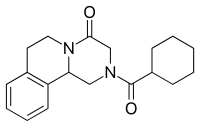praziquantel
English
WOTD – 25 July 2017
Etymology

The skeletal formula of praziquantel

A scanning electron microscope image of a tapeworm (Cestoda). Praziquantel can be used to treat tapeworm infections.
Blend of p(y)razi(ne) + qu(inoline) + ant(h)el(mintic). The drug was developed by the German pharmaceutical companies Bayer and Merck in the mid-1970s. The name is established as the drug’s international nonproprietary name, and follows the -antel suffix pattern for the general anthelmintics category of pharmaceutical products.
Pronunciation
- (Received Pronunciation, General American) IPA(key): /ˌpɹæzɪˈkwæntɛl/
- Hyphenation: pra‧zi‧quan‧tel
Noun
praziquantel (uncountable)
- An anthelmintic medication used to treat a number of types of parasitic worm infections, including clonorchiasis, cysticercosis, opisthorchiasis, schistosomiasis, and tapeworm infections. [from 1970s]
- 1977 July, R. Gönnert; P. Andrews, “Praziquantel, a New Broad-spectrum Antischistosomal Agent”, in Zeitschrift für Parasitenkunde, volume 52, number 2, DOI:, abstract, page 129:
- Praziquantel, (2-cyclohexylcarbonyl)-1,2,3,6,7,11b-hexa-hydro-2H pyrazino[2,1a]isoquinolin-4-one, belongs to a new series of antischistosomal compounds. The results of a detailed study of the efficacy of praziquantel on Schistosoma mansoni in mice, Mastomys and Syrian hamsters are described.
- 1997, Roy Porter, The Greatest Benefit to Mankind: A Medical History of Humanity from Antiquity to the Present, London: HarperCollins Publishers, →ISBN; republished London: Folio Society, 2016, OCLC 954719670, page 470:
- In the case of schistosomiasis, […] the techniques of molecular biology are being used to seek vaccines, and praziquantel has transformed therapy.
- 2009 May 26, Donald G[erald] McNeil Jr., “Parasites: Giving a deworming drug to girls could cut H.I.V. transmission in Africa”, in The New York Times, archived from the original on 27 March 2011:
- The drug praziquantel, which costs only 32 cents per child, would prevent schistosomiasis, a worm disease that starts as a urinary tract infection but, untreated, can lead to female genital sores that make it easier for H.I.V. to enter.
-
Further reading

This article is issued from
Wiktionary.
The text is licensed under Creative
Commons - Attribution - Sharealike.
Additional terms may apply for the media files.